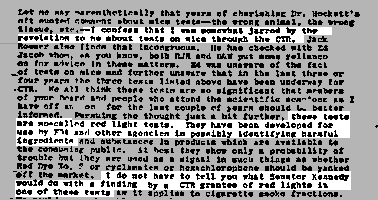Act II, Scene 3: Enter the Lawyers

"I confess that I was somewhat jarred by the revelation
to me about tests on mice through the CTR (because)...these tests are so-called
red light tests...developed for use by FDA and other agencies in possibly
identifying harmful ingredients...I do not have to tell you what Senator
Kennedy would do with a finding of red lights in one of these tests..."
Pepples memo, 1910.02, p.1
By the mid-seventies, the Harrogate lab had been shut down. Health studies
continued, but the grand project of developing a safe cigarette was largely
abandoned. Research shifted toward finding ways to minimize tar while maintaining
nicotine levels, refinements that might make B&W products more competitive,
and at least as addictive.
Lawyers ran the research now, clearing projects before they were allowed
to start, and shutting down others that would look bad if discovered by
a sick smoker suing the tobacco companies for manufacturing a faulty product
(Pepples memo, 1910.02, p.1).
By supervising the science effort, the lawyers hoped they could prevent
plaintiffs from getting hold of damaging research. Their legal argument
was that, since they were lawyers, pretty much anything they laid their
hands on, including scientific reports, became "privileged" or
confidential because it was part of the attorney-client relationship.
That way, theoretically at least, it couldn't be seen by a plaintiff. This
remains their argument today.

"The point here is the value of having CTR doing work in
a non-directed and independent fashion as contrasted with work either in-house
or under B&W contract which, if it goes wrong, can become the smoking
pistol in a lawsuit."
Pepples memo, 1821.01, p.1
Brown & Williamson used lawyers in this way, as did the Council for
Tobacco Research (CTR), the descendant of the old TIRC which the American
companies formed in 1953. At CTR, lawyers controlled a program of research
that was done secretly on behalf of the entire industry. (Pepples
memo, 1821.01). There, this type of work was given a name: "Special
Projects." (Shinn
letter, 3/9/78, 2015.01)
Starting in the late seventies we begin to see more and more memos like
1910.02, the so-called
"red lights" memo - orders not to do certain studies for legal
reasons. In fact, probably the biggest single category in the B&W papers
are letters from lawyers.



|
|